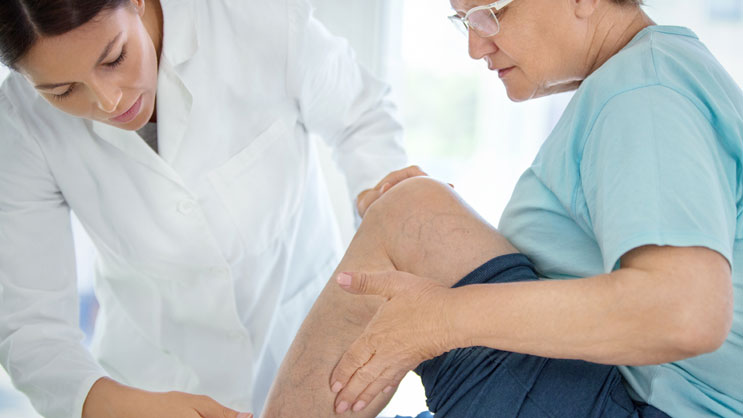More than half of American adults have raised, discolored veins that produce swelling in the ankle, along with sore, achy legs. These are called varicose veins, and left untreated, they can lead to more serious health problems.
People who spend too much time on their feet are prone to varicose veins, and those with a family history of vein disease are even more at risk. Standing desks are often regarded as a healthier option to sitting all day, but they are not healthier for everyone.
Danielle Bajakian, MD, a leading expert on vein disease at Columbia, debunks some common myths about vein disease.
Did you know that Columbia’s vein experts now offer vein screenings in Midtown Manhattan? You can call (866) 697-7755 to schedule an appointment. Learn more about vein screenings in Midtown.
Myth #1: Irregular veins are a cosmetic problem.
Many people with big bulgy, ropy veins have been told by their doctors that vein disease isn’t life threatening, so they ignore them. But if left untreated, what starts as a manageable issue can lead to potentially dangerous complications. Even before reaching that point, symptoms of vein disease are frequently agonizing.
“Often patients complain of leg and ankle swelling, and a general tiredness and lack of energy,” says Dr. Bajakian. “And vein disease is significantly affecting their quality of life.” At this stage, some vein problems and skin changes are irreversible. So the best thing is to get evaluated right away.
Myth #2: Spider veins and varicose veins are the same.
Spider veins are lacey vein on the surface of the skin that typically don’t cause any symptoms or do any harm. These can be treated easily and quickly for cosmetic improvement.
Varicose veins are large and discolored. They don’t appear as pronounced in morning. But by the end of the day, they are swollen and blue. These are signs of more advanced disease.
Schedule a vein screening with a Columbia vein expert by calling (866) 697-7755. Learn more about vein screenings in Midtown.
Myth #3. Men don’t get varicose veins.
Yes, varicose veins are more common in women, but they still affect a significant number of men—especially those who have a family history of vein disease.
The problem is that too often, men ignore the disease until it has progressed. “They may be embarrassed to go for an evaluation, because they think of this as a vanity issue,” says Dr. Bajakian. “As a result, men minimize their symptoms, assuming that achy tired legs are the natural result of hard, physical work. They also assume that the pain is something they have to live with. But they don’t have to suffer. We can help.”
Myth #4: Vein disease is a problem of old age.
Dr. Bajakian sees many patients in their 20s with vein disease. “Right now 10 to 20 percent of those in my practice are under the age of 40,” she says. “As they get older, their vein problems will progress. So it’s good to address this condition early.”
Myth #5: You shouldn’t take care of varicose veins until you’re done having children.
Many women with varicose veins wait until they have finished bearing children to get help. They assume that each pregnancy will make the problem worse.
“While I don’t recommend treatment during pregnancy,” says Dr. Bajakian, “I do advise women to address this condition before they have their next child. And it can alleviate some of the leg swelling most women experience during pregnancy.”
Myth #6: Exercise is bad for your veins.
People often ask if exercise can cause vein problems. It’s just the reverse. Exercise helps improve circulation. Any activity that gets the calf muscles pumping, like walking or running, will help to increase venous return.
Standing around in one position, however, puts you at higher risk for the symptoms of vein disease—and that’s why hairdressers, pharmacists, chefs and surgeons are more likely to have this condition.
“Prolonged standing allows blood to pool in the ankles, putting stress on your veins,” says Dr. Bajakian. One of her patients bought a standing desk, then noticed that her legs felt achy and tired. “By standing all day, she was putting increased pressure on her veins,” Dr. Bajakian said. “So I told her, Go back to your old desk, and make sure to get up and walk around at different intervals.”
Myth #7: The cure for vein disease is painful and time-consuming.
Treatments for varicose veins used to involve surgery and require a long recovery period. Today, these procedures are done in an office setting under local anesthesia. Patients can go back work and head to the gym the very next day.
Discolorations and distensions are caused when blood pools in a vein, just underneath the skin. Using a thin wire tube called a catheter, surgeons seal off the affected vein and dry up the blood supply.
“We have several methods to accomplishing that,” says Dr. Bajakian. “One technology uses the heat generated by laser or high frequency radio waves to seal off the vein. Another uses a surgical glue.”
Vein Disease may not be a life-threatening problem but it is a health problem. Patients looks and feel much better, after treatment. “If you have any concerns at all, come to a screening,” adds Dr. Bajakian. “We have many ways to help you that are fast, easy, and minimally invasive.”
Screenings take less than ten minutes. Participants are examined individually in a private environment and should wear loose-fitting clothing.
Learn more about vein screenings in Midtown.
Learn more about the Vein Program.
Sign up for our mailing list for more health news and information from Columbia.

